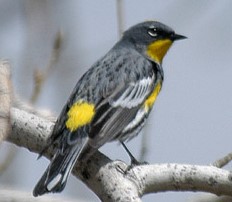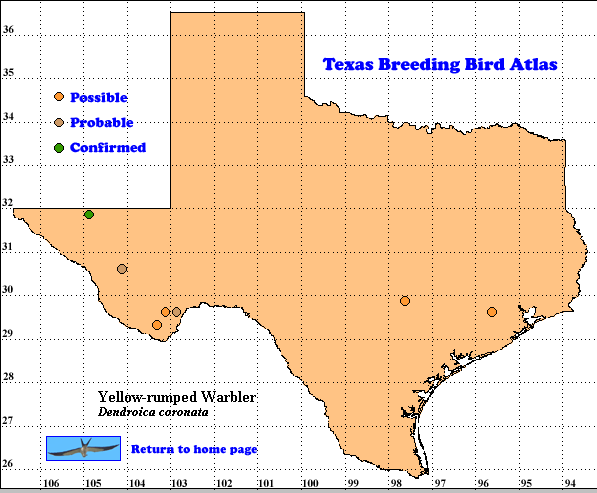The Yellow-rumped Warbler is one of the most common breeding warblers in North America and the most common warbler in the United States in winter.At this season it changes its diet from insects to fruits.
The taxon was formed by lumping the white-throated Myrtle Warbler with the yellow-throated Audubon’s Warbler, both long considered separate species. These two identifiable forms have similar plumages and life histories and interbreed in a narrow area of British Columbia and Alberta where their ranges overlap.
Non-breeding plumages of both races are duller and more easily confused with other species. See Pyle (1997) and Hunt and Flaspohler (1998) for plumage details.
DISTRIBUTION. During the 1987-1992 field work of the TBBA project, observers found 7 locations with possible, probable or confirmed breeding evidence. The confirmed breeding record found in the Guadalupe Mountains and the probable in the Davis Mountains of Trans-Pecos Texas, match the locations described by Lockwood and Freeman (2004) where the Audubon’s race of the Yellow-rumped Warbler is a summer resident. The probable and 2 possible records in Big Bend National Park probably also represent the Audubon’s race. The area deserves further study since breeding has not been reported there. The 2 possible records from further east may be late migrants of either the Myrtle or Audubon’s groups; both groups winter in this area
In migration and winter, the Audubon’s race is most commonly found in Texas in the Trans-Pecos region.while the Myrtle group is more common in the eastern two-thirds of Texas.
The winter range of the Myrtle race in Texas overlaps that of the Audubon’s. (Lockwood and Freeman 2004).
Elsewhere in western North America one subspecies of the Audubon’s group breeds in the higher mountains from British Columbia and Alberta south to northern Baja California (Mexico), Arizona and New Mexico. Isolated resident populations of two other subspecies are found in the mountains of northwest Mexico and in Chiapas (Mexico) and adjacent Guatemala. The northern subspecies of Audubon’s group winters from Vancouver Island south along the Pacific Coast to central California and in Arizona, southern New Mexico and south through Mexico to the Isthmus of Tehuantepec (Hunt and Flaspohler 1998).
The Myrtle group breeds from Alaska east across Canada to Newfoundland. The southern boundary extends from Alberta to the northern parts of the Great Lakes and middle Atlantic states and New England. This race spends the winter in a variety of areas: along the West Coast from Washington to California, eastern New Mexico and the southeastern and prairie states from eastern Nebraska south to the Gulf Coast. The winter range also includes most of Mexico and Central America, Cuba, Puerto Rico and the Bahamas (Hunt and Flaspohler 1998).
SEASONAL OCCURRENCE. The Audubon’s race of Yellow-rumped Warbler migrates through Texas from late March to mid-May. It probably breeds from early May to mid-August, and returns south between late September and late November.
The Myrtle group migrates through Texas mostly between mid-March and late April. Most southbound migrants are present between mid-October and mid-December. Since both races are found in Texas through the winter, migration dates are difficult to define precisely (Oberholser 1974, Lockwood and Freeman 2004).
BREEDING HABITAT. The Audubon’s race of the Yellow-rumped Warbler has been found nesting in conifers above 2100 m (7000 ft) in the Guadalupe Mountains of Trans-Pecos Texas. This race usually builds its nest near the trunk on a horizontal conifer branch about 6 m (20 ft, range 1-15 m [3-50 ft]) above ground. The nest, a neat, deep cup, is built of small twigs; bark strips and plant down and fibers. It is lined with hair, fine grasses and many feathers, which are woven into the rim of the cup with tips facing inward so the eggs are concealed when the female is not incubating. The outside diameter is 8-9 cm (3-3.5 in), height 6 cm (2.3 in), inside diameter 5 cm (2 in) and cup depth 4 cm (1.5 in).
The female usually lays 4 (range 3-5) greenish to cream-white eggs (see Harrison [1979] for photo of markings). She incubates then for 12-13 days. The young birds leave the nest at 10-14 days after hatching. A pair may attempt more than 1 brood per year. Brown-headed Cowbirds (Molothrus ater) may parasitize as many as 31% of nests (Oberholser 1974, Harrison 1979, Hunt and Flaspohler 1998, Lockwood and Freeman 2004).
STATUS. Lockwood and Freeman (2004) describe the Audubon’s race of Yellow-rumped Warbler as an uncommon to locally common migrant in the Trans-Pecos, Panhandle and South Plains, and an uncommon to rare migrant and winter visitor to the Rolling Plains and Edwards Plateau. In the breeding season this race is uncommon and local at the highest elevations of the Davis and Guadalupe mountains of the Trans-Pecos region.
Lockwood and Freeman (2004) report the Myrtle race as a common to locally abundant migrant and winter resident in the eastern two-thirds of Texas, becoming less common through the rest of the state.
The North American Breeding Bird Survey does not sample Yellow-rumped Warblers in Texas due to the inaccessibility of its breeding locations. Data from the western region where the Audubon’s race breeds show a 95% confidence interval (in 19 of 20 cases, the actual trend will be between these two figures) for the period 1966-2003 of -0.7 to +0.9% population change per year (Sauer et al. 2004), suggesting any change in population size is small.
Since both races of the Yellow-rumped Warbler are common as migrants and winter residents in much of Texas, birdwatchers should be able to see these birds in this state well into the future. Text by Robert C. Tweit (2004)
Literature cited:
Harrison, H. H. 1979. A field guide to western birds’ nests. Houghton Mifflin, Boston, MA.
Hunt, P. D. and D. J. Flaspohler. 1998. Yellow-rumped Warbler (Dendroica coronata). In The Birds of North America, No. 376 (A. Poole and F. Gill, eds.). The Birds of North America, Inc., Philadelphia, PA.
Lockwood, M. W. and B. Freeman. 2004. The TOS handbook of Texas birds. Texas A&M University Press, College Station.
Oberholser, H. C. 1974. The bird life of Texas, Vol. 2. University of Texas Press, Austin.
Pyle, P. 1997. Identification guide to North American birds, part 1. Slate Creek Press, Bolinas, CA.
Sauer, J. R., J. E. Hines, and J. Fallon. 2004. The North American Breeding Bird Survey, results and analysis 1966-2003. Version 2004.1. USGS Patuxent Wildlife Research Center, Laurel MD (Web site, http://www.mbr-pwrc.usgs.gov/bbs

